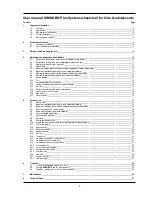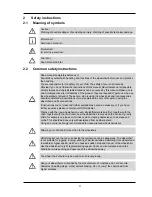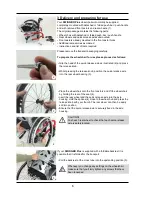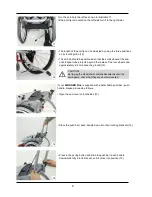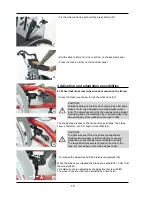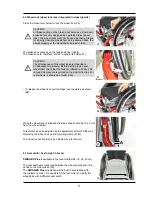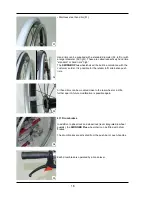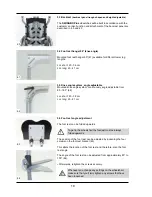
4
To clear obstacles such as steps and curbs, tilt the wheelchair onto the rear wheels (pull it
backwards to go up; to descend, slowly lower it forward).
If only one attendant is available when ascending or descending stairs, an incorrectly set
anti-tip (if mounted at all) can lead to severe falls. Adjust the anti-tipper so that it does not
come in the way of the steps during transport. Afterwards, swing the anti-tipper back to its
operational position.
Do not go up or down stairs without the assistance of another person. If devices such
as ramps or elevators are available, please use them. Ensure that the anti-tip (if mounted)
is outside the danger-area. If wheelchairfriendly access is missing, two attendants must
carry the wheelchair over the obstacle.
When ascending slopes or ramps and when crossing obstacles on upward slopes, always
lean the wheelchair user‘s upper body far forward.
When descending slopes, do not drive without braking and reduce your speed. Reduced
load on the casters due to centre of gravity shifting can cause the casters to flutter.
If you have to park on a slope, face the wheelchair uphill with the brakes engaged and
ensure that the seat is in the upright position. There is a risk that the pushchair might tip
over backwards if the seat is the reclined position.
Before leaving the wheelchair and before getting into and out of it, always lock the wheel
locks.
It is only allowed for children with a body weight less than 20 kg to stand on the footplate
getting into the wheelchair.
For children above 20 kg fold up the footplate before getting into or out of the wheelchair.
Depending on footplate settings and wheelchair geometry, the wheelchair may tip over if
the user boards the chair using the footplate. First practise boarding the chair with the child
and an attendant who can secure the wheelchair, and modify footplate and seat height
settings if the chair has a tendency to tip over. In addition, turn the caster fork to the front
prior to using the footplate for getting into the wheelchair; this increases the wheelbase
and thereby the wheelchair‘s stability against tipping.
The effectiveness of the wheel lock and the overall driving quality are dependent on
adequate air pressure. With properly inflated rear wheels and even tyre pressure on both
sides, your wheelchair is much easier to operate and manoeuvre. Before starting to use
your wheelchair, check that the tyres are inflated correctly. The required air pressure is
printed on the side of the tyre. For rear wheels, it should be at least 6 bar.
All brakes acting on the tyres do not serve as service brake but are only designed as
parking brake (wheel lock). The wheel locks must not be used as driving brakes for slowing
down the wheelchair, as in extreme cases, the abrupt stopping of the wheelchair can lead
to falls.
Please keep packaging material away from children. Plastic packaging presents the
danger of suffocation.
Disposal of waste: The packaging material as far as metal, aluminium and plastic parts can
be recycled. The recycling must be operated according to the national and legal terms.
Never leave your child unattended in the wheelchair even when they are strapped in and
the brakes engaged.
In the dark, the user should wear light clothing or clothing with reflectors in order to improve
visibility. Ensure that the reflectors installed on the sides and rear of the wheelchair are
easily visible. We also recommend installing active illumination.


